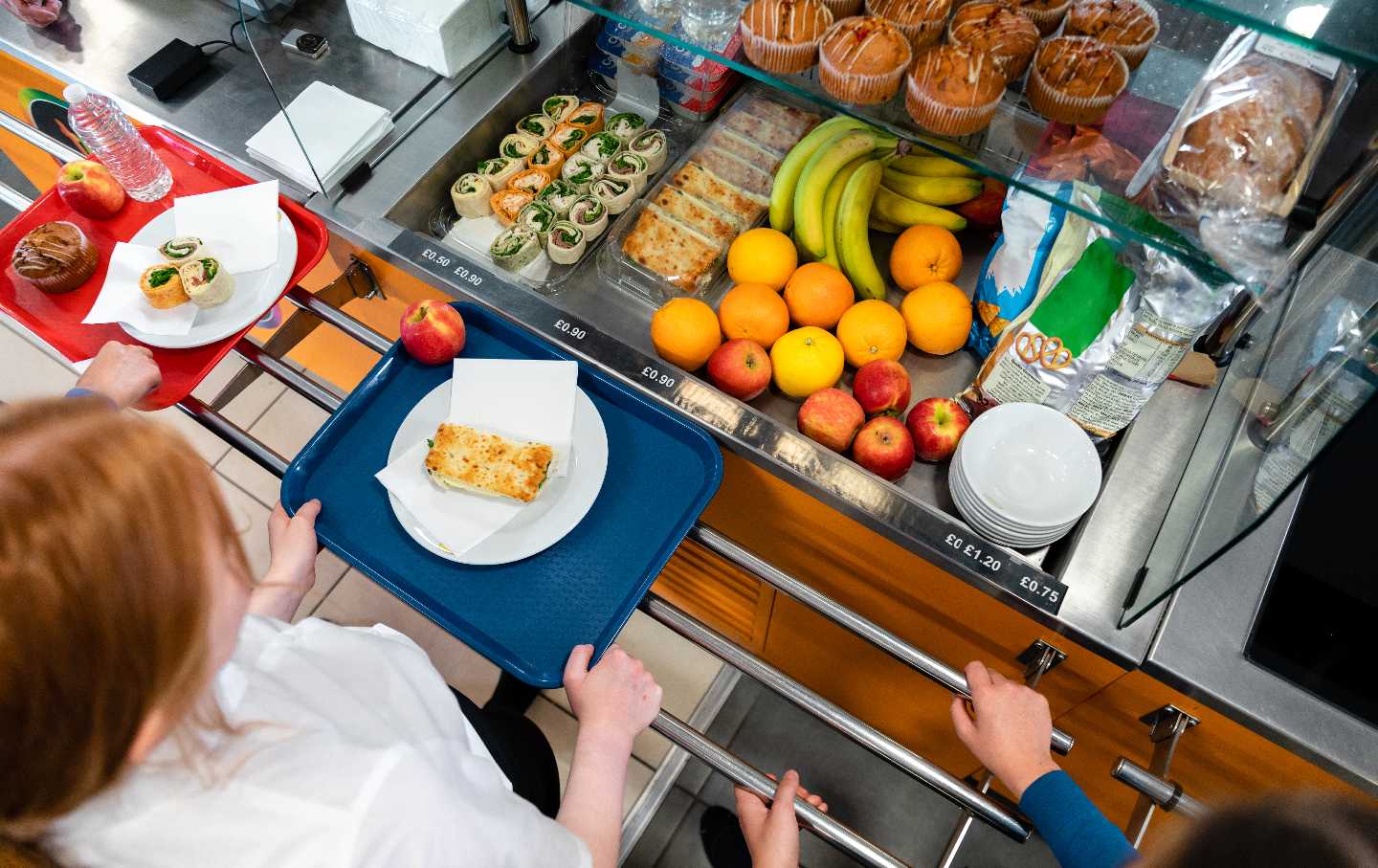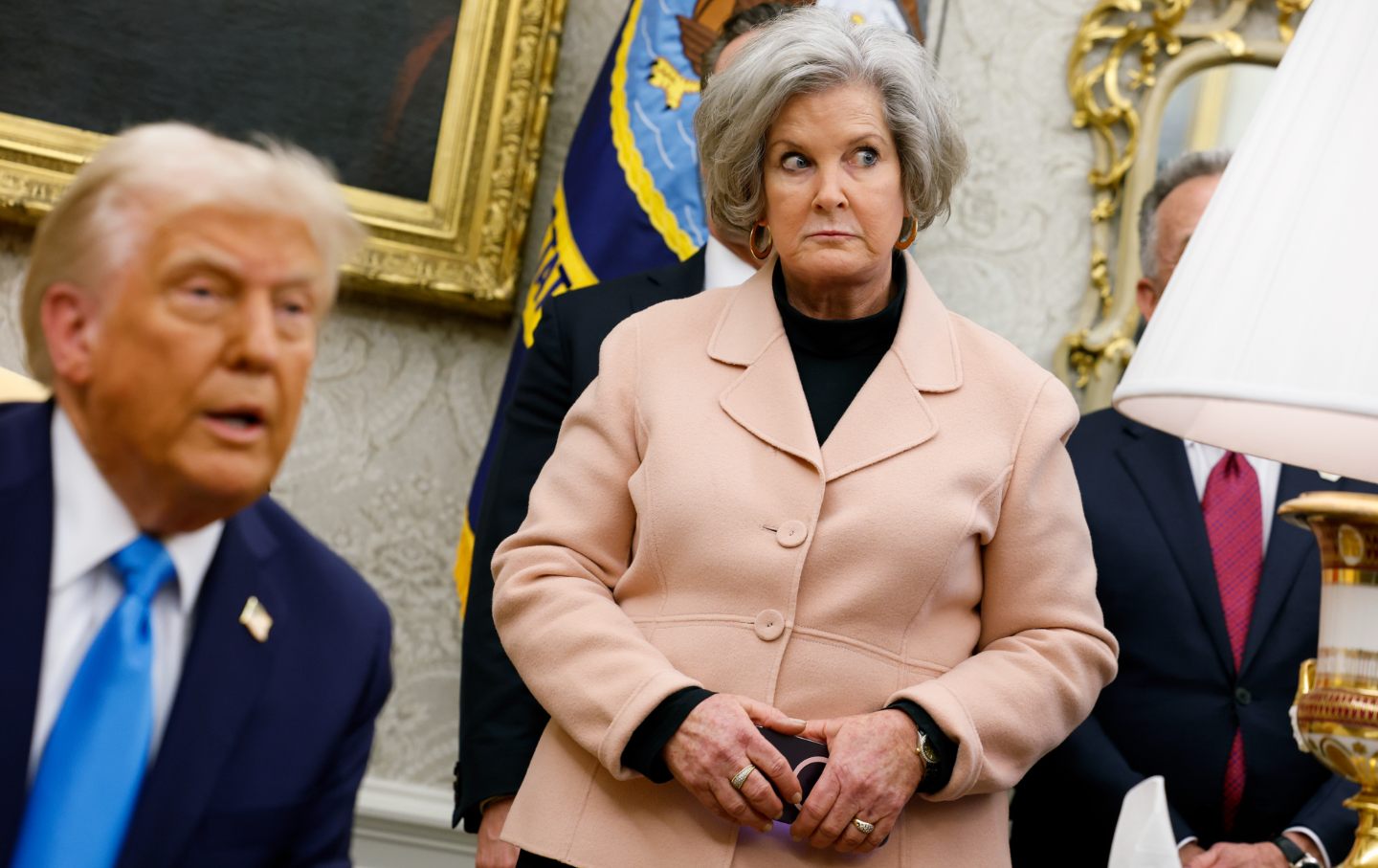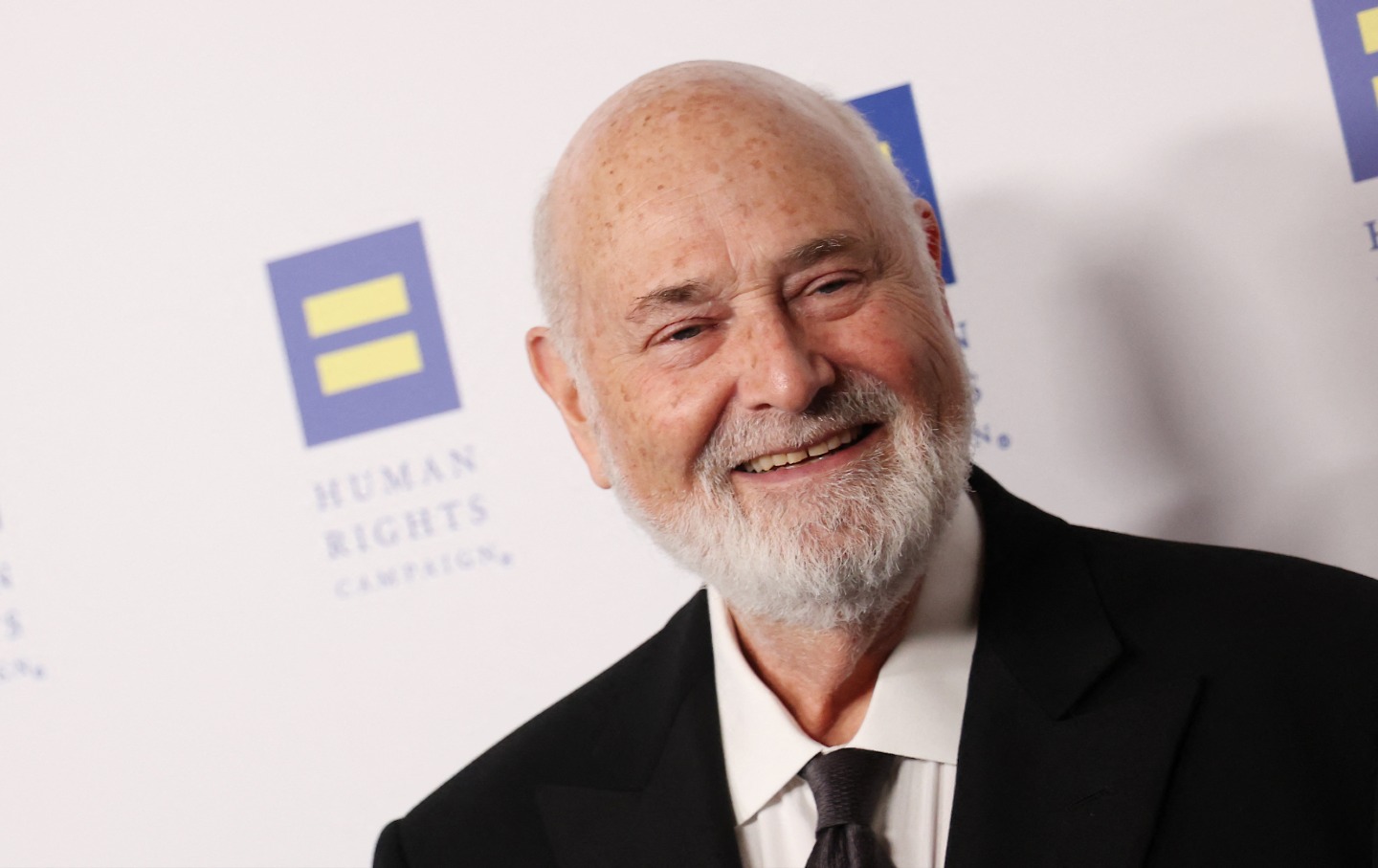Free School Lunches Kept Millions of Kids Fed During the Pandemic. Why Stop Now?
In North Carolina, the ending of the Covid-era federal meals program devastated low-income communities–and legislators have been slow to face the crisis.

A student looking at the options for their school lunch.
(SolStock / Getty)From her small apartment in Durham, N.C., Marcella Thompson prepares healthy meals and groceries for the dozens of families that struggle to put food on the table in her neighborhood.
“They can’t afford to buy it for their families, [so] farmers give us organic produce,” said Thomspon. “They have fruit, they have blueberries, they have strawberries, they [have] melons and greens and potatoes and so parents are able to give their kids nutritious meals.”
The Mustard Seed Project receives donations of locally grown fruit and vegetables, which they distribute in grocery bags to families. Recently, Thompson has also started to bring in treats to local neighborhoods, with food trucks and live music. “[We’re] able to take an ice cream truck, take a band, have nutrition meals, and play the music, go out into the complex and the children will come out, get their meals, go back in their [houses] and we move onto the next complex.”
Many of the low-income families Thompson serves relied on free lunch programs through the pandemic. North Carolina, along with the rest of the country, ended its pandemic era federally-funded free school meals program in September 2022, which provided over 1.4 million students in the state with free breakfasts and lunches. All other states also saw the federal support for their school meal programs disappear.
One school year later, communities in North Carolina have already experienced the catastrophic consequences of the program’s end. The state has historically struggled with food insecurity, even before the pandemic; 13.5 percent of children struggled with hunger in 2019, placing it as the 10th-hungriest state. “It had a really devastating impact on children—and not just poor children, but even middle class children.” Although qualifying students can still access free or reduced-price meals after the end of the program, various factors, including food stigma and rigid income-cutoffs, exclude students who are in need of the meals the most.
Andrew Harrell, a communications specialist at the Carolina Hunger Initiative and nonprofit No Kid Hungry, said that school meal programs are vital to students’ academic performance and focus in the classroom. “School meals don’t just fight food insecurity but are a big part of academic excellence for a lot of kids. They help kids feel socially and emotionally secure in the classroom.” Free school meals also take a burden off of struggling families, like the ones Thompson serves through the Mustard Seed Project. “Not all families know [where] their next meal is going to come from,” said Harrell. “Having access to school meals for free at no cost to families was a huge, huge benefit during the pandemic and the ability to access those meals at no cost to families.”
Current qualifications for free school lunch rely on a system of strict income cutoffs, so students who fall just over the required guidelines are passed over for services that they need. In 2019, a four-person household would need an annual income of $33,475, or less, to qualify for free school lunch. Even though the cutoff rose to $39,000 for the upcoming school year to include more families, it ignores those that make just above that value; a family of four making $39,100 wouldn’t qualify.
This leaves a demographic of families who are unable to access the necessary support they need to feed their families, and places strain on food banks and other local organizations in providing for families. Oftentimes, these organizations don’t receive the funding they need to serve at the level that is needed. “It’s kind of been an unfortunate timing where these programs have ended, [and] this [forced] a lot of families to bring higher demand on food banks and food pantries,” said Harrell.
Thompson’s work introduces another key aspect that free school meals were able to provide: nutrition. “A lot of people don’t appreciate how healthy school meals are. Tufts University did a 15-year study that was recently completed and found out that school meals are the healthiest source of food for many Americans,” said Harrell. The investigation found that the percentage of unhealthy school meals programs decreased from 55.6 percent to 24.4 percent; significant disparities in diet quality relating to education and income levels were also reported.
At home, a majority of the kids Thompson serves eat highly processed, cheap, and easy-to-make food. These dietary habits can adversely impact children’s health later in life, and lead to increased risk of obesity and certain cancers.
Even though schools host summer meals programs across the state for summer break, the students that need them most are often unable to access them. “There are a few programs that are delivering lunch to children, but they’re in specific areas,” said Thompson. “There is no access.”
In the legislature, several North Carolina lawmakers are fighting to change recent policies, including Representative Julie von Haefen. “We’re still in the middle of our state budget negotiations,” said Haefen. “There’s still a lot of advocacy around this issue from a lot of the coalition partners. School Meals for All North Carolina which is a big group that’s been down here almost every week this session, advocating for this funding to be [put] into the state budget.”
The lack of attention from legislators towards food insecurity and school nutrition is frustrating, said Haefen. “We’ve been focusing on all the wrong issues this year.” Alongside Representative Cynthia Ball, Haefen introduced House Bill 844, titled the “School Meals for All Act,” which would reestablish the free school meals program. The bill gives public schools the power to establish “school nutrition services in the schools, under their jurisdiction.”
Popular
“swipe left below to view more authors”Swipe →“Data shows that offering no cost school meals to students reduces hunger, it improves academic performance. And if we really want to be focused on improving the lives of kids in our state, these are the types of those we should be focused on,” Haefen said.
The North Carolina legislature, however, lacks similar enthusiasm. Haefen remains hesitant as to whether the bill will garner enough support to pass, despite advocates’ efforts.
It’s not a funding issue. House Bill 844 would cost just $172 million to implement, according to the filed bill—a tiny fraction of the state’s $27.9 billion budget for 2022. It’s also not because of a lack of evidence that universal school meal programs are effective. Vermont and Minnesota, two states that signed universal free lunch bills into law this past school year, are among the most food secure states in the county, with 8.9 percent and 6.8 percent of residents struggling with hunger, respectively.
But mitigating food insecurity requires more effort than the passage of a single bill. According to Harrell, building resilient food systems requires support from every level of the community, from politicians to parents. “It seems like every year there are some independently written bills that try and address funding more meals for kids. And we’re always excited to see those come out. But we are really focused on finding ways to work at the local and state and the national level for the long term with partners statewide to try and make [this] happen.”
Several bills under the 2023 Farm Bill encompass the long-lasting, sustainable change that Harrell emphasizes. Among them, national bills Improving Access to Nutrition Act and Closing the Meal Gap Act were both introduced to Congress in 2023.
“I have a real difficult time when we have our legislators that are supposed to represent all of us, not certain people,” said Thompson, mentioning the importance for lawmakers to represent this issue in the legislative chambers. “There’s a problem there. And there’s a real disconnect with the people that they’re supposed to be serving.”
Thompson hopes to visit Washington, D.C., in the coming months to speak out on a national level. “Every child, in every state had free lunch no matter what the condition was,” she said. “And if you’re getting through in Covid, why can’t you continue that program?”
Disobey authoritarians, support The Nation
Over the past year you’ve read Nation writers like Elie Mystal, Kaveh Akbar, John Nichols, Joan Walsh, Bryce Covert, Dave Zirin, Jeet Heer, Michael T. Klare, Katha Pollitt, Amy Littlefield, Gregg Gonsalves, and Sasha Abramsky take on the Trump family’s corruption, set the record straight about Robert F. Kennedy Jr.’s catastrophic Make America Healthy Again movement, survey the fallout and human cost of the DOGE wrecking ball, anticipate the Supreme Court’s dangerous antidemocratic rulings, and amplify successful tactics of resistance on the streets and in Congress.
We publish these stories because when members of our communities are being abducted, household debt is climbing, and AI data centers are causing water and electricity shortages, we have a duty as journalists to do all we can to inform the public.
In 2026, our aim is to do more than ever before—but we need your support to make that happen.
Through December 31, a generous donor will match all donations up to $75,000. That means that your contribution will be doubled, dollar for dollar. If we hit the full match, we’ll be starting 2026 with $150,000 to invest in the stories that impact real people’s lives—the kinds of stories that billionaire-owned, corporate-backed outlets aren’t covering.
With your support, our team will publish major stories that the president and his allies won’t want you to read. We’ll cover the emerging military-tech industrial complex and matters of war, peace, and surveillance, as well as the affordability crisis, hunger, housing, healthcare, the environment, attacks on reproductive rights, and much more. At the same time, we’ll imagine alternatives to Trumpian rule and uplift efforts to create a better world, here and now.
While your gift has twice the impact, I’m asking you to support The Nation with a donation today. You’ll empower the journalists, editors, and fact-checkers best equipped to hold this authoritarian administration to account.
I hope you won’t miss this moment—donate to The Nation today.
Onward,
Katrina vanden Heuvel
Editor and publisher, The Nation
More from The Nation

The Shocking Confessions of Susie Wiles The Shocking Confessions of Susie Wiles
Trump’s chief of staff admits he’s lying about Venezuela—and a lot of other things.

The King of Deportations The King of Deportations
ICE’s illegal tactics and extreme force put immigrants in danger.

How Rob Reiner Tipped the Balance Against Donald Trump How Rob Reiner Tipped the Balance Against Donald Trump
Trump’s crude disdain for the slain filmmaker was undoubtedly rooted in the fact that Reiner so ably used his talents to help dethrone him in 2020.

The Economy Is Flatlining—and So Is Trump The Economy Is Flatlining—and So Is Trump
The president’s usual tricks are no match for a weakening jobs market and persistent inflation.

Trump’s Vile Rob Reiner Comments Show How Much He Has Debased His Office Trump’s Vile Rob Reiner Comments Show How Much He Has Debased His Office
Every day, Trump is saying and doing things that would get most elementary school children suspended.



